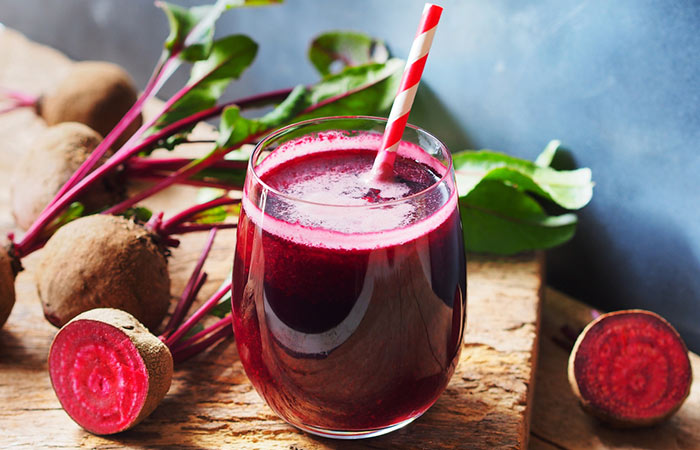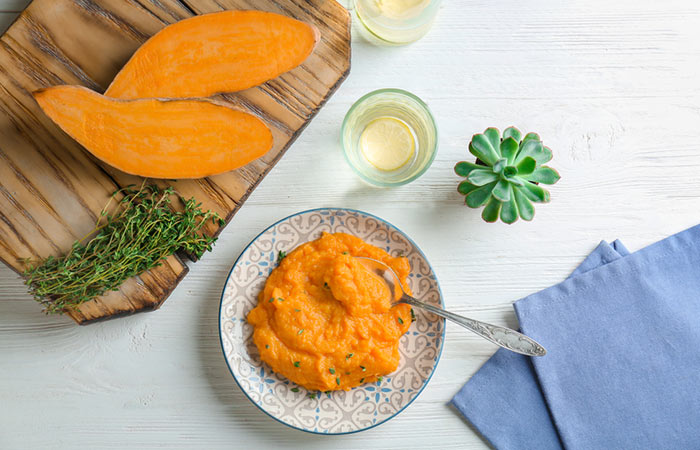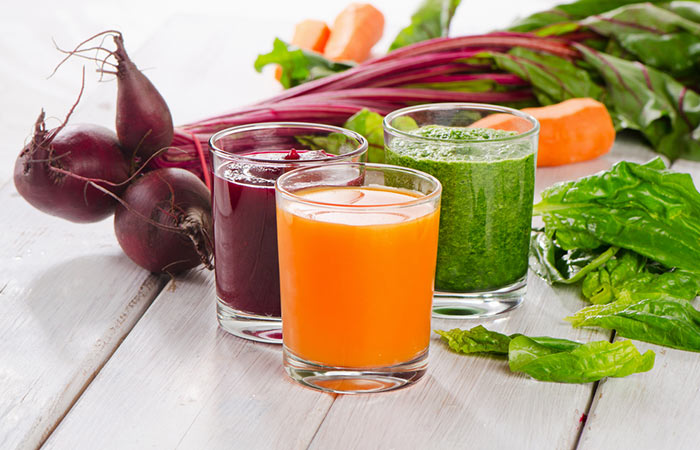List Of 30 Best Oxygen-Rich Foods To Boost O2 Levels
Consuming oxygen-rich foods can help in growth and sustaining life (1). It is vital to maintain 94-98% oxygen saturation in the blood to forestall hypoxia and tissue damage (2), (3). Hypoxia or depression oxygen saturation may lead to asthma, lung disorders, COVID-19 complications, fibromyalgia, and heart affliction or may worsen an existing health problem (4), (5), (six), (vii), (8). Checking your oxygen saturation levels regularly with a pulse oximeter, getting medical attending, and adding foods rich in oxygen can be of tremendous assistance.
This article lists the 30 best foods – including fruits, proteins, vegetables, and drinks – yous may consume to heave your blood oxygen levels. Scroll down to take a look.
How Foods Help Boost Oxygen Levels
It is important to understand why certain foods assist improve oxygen levels. These foods are not "oxygen-rich" per se. They contain vitamins, minerals, and molecules and accept an alkaline metal pH, essential for maintaining optimal claret menses and oxygen levels in the torso.
The foods to expect for must be rich in vitamins A, B2, B3, B5, B9, and B12, minerals like atomic number 26 and copper, and the molecule nitric oxide. Cull alkaline foods that reduce the adventure of stroke and hypertension, improve heart and brain function, and activate vitamin D (9).
Let's get started with the list of foods to swallow to boost the oxygen levels in your claret. Whorl downward.
30 All-time Foods To Improve Oxygen Levels
10 Fruits To Boost Oxygen Levels
1. Avocados
Avocados are rich in vitamins A, B3, B6, B12, choline, folate, polyunsaturated fatty acids (PUFAs), and dietary fiber. These nutrients aid boost oxygen levels, reduce cholesterol, promote a healthy heart, control blood sugar levels, improve lipid contour, protect DNA, prevent osteoarthritis, improve eye health, and help in weight direction (10).
Consume one-half an avocado every solar day in smoothies, salads, or delicious tacos to requite your oxygen levels a boost and improve your overall health.
two. Pomegranate
Pomegranates contain iron, copper, zinc, vitamins B3 and B6, and choline (11). They improve blood menstruum by increasing nitric oxide bioavailability and boost oxygen delivery (12). Consuming pomegranate kernels or freshly pressed pomegranate juice helps dilate the blood vessels, enabling improved claret flow (13). This reduces the risk of tissue damage due to depression oxygen saturation.
Consume a loving cup of pomegranate kernels, drink 375 ml of pomegranate juice per day, or add it to salads and include this oxygen saturation-improving alkaline nutrient in your nutrition.
iii. Kiwi
Shutterstock
This sugariness 'n sour juicy tropical fruit is a good source of dietary cobweb, copper, iron, vitamins A, B3, B5, B6, and C, choline, and several antioxidants. Kiwifruit helps preclude DNA damage, boosts the allowed system, reduces the severity and duration of upper respiratory infections in the elderly, and lowers inflammation (fourteen).
Consume a large kiwi per day. You tin can also add information technology to smoothies, juices, and salads to increase the consumption of vitamins and minerals that help increase oxygen saturation in the blood.
iv. Cantaloupe
Cantaloupe is a not bad source of vitamins A, B3, B5, B6, C, choline, folate, iron, and antioxidants (15). This fruit is low in saccharide and tin exist consumed by people with loftier blood sugar levels. It besides has anti-inflammatory and immunity-boosting backdrop (16).
Eat a loving cup of cantaloupe or make a smoothie to better oxygen levels in the body.
five. Mango
Ripe mangoes are rich in vitamins A, B3, B5, B6, and C, and atomic number 26 and copper essential for upping blood oxygen saturation levels. They contain antioxidants like vitamin C, carotenoids, and phenolic compounds that help maintain overall health (17). Mangoes have hypotensive, anti-inflammatory, hepatoprotective, and amnesty-boosting properties (18).
Consume half a loving cup of ripe mangoes, toss them with breakfast fruit bowls, or brand a smoothie. People with diabetes must consult their doc before consuming ripe mangoes every bit they have high saccharide content.
vi. Peaches
Peaches are loaded with vitamins A, B3, B5, and B6, iron, zinc, and antioxidants that prevent free radical damage and help maintain proper torso functions. These delicious summer fruits are touted as functional foods due to their capacity to promote overall health (19), (20).
Consume a whole big peach a mean solar day or every other mean solar day. Yous can also add it to your juices, smoothies, or cold salads.
7. Pineapple
Shutterstock
Pineapples are an excellent source of vitamins A, B3, B5, B6, and C, copper, fe, potassium, zinc, choline, folate, and beta-carotene (21). These sweet and juicy tropical fruits help increase the permeability of the blood vessel walls to oxygen and other nutrients. The active component of pineapple, bromelain, likewise helps reduce inflammation and prevents claret jell formation (22).
Eat a cup of pineapple as is, or add it to smoothies, juices, and salads.
8. Berries
Blueberries, strawberries, and raspberries are not bad sources of vitamins A, B3, B5, B6, and C, atomic number 26, potassium, copper, zinc, choline, folate, and antioxidants (23), (24), (25). Berries too help reduce inflammation and lipoprotein-cholesterol levels and improve insulin sensitivity (26).
Consume a cup of organic or locally grown mixed berries every solar day. Include them in fruit bowls, smoothies, and juices.
9. Figs And Dates
Dried figs and dates are loaded with iron, copper, potassium, vitamins A, B3, B5, and folate (27), (28). These nutrients help boost immunity and improve cognitive abilities. Dates and figs are rich in polyphenols with antioxidant properties and assist reduce free radical harm and oxidative stress to prevent neurodegeneration and provide therapeutic effects (29), (thirty).
Consume 1-two medjool dates and a couple of dried figs with smoothies. People with diabetes must consult their doctor before consuming stale figs and dates as they have high sugar content.
10. Citrus Fruits
Citrus fruits are rich in vitamin C, an antioxidant that helps develop hemoglobin-based oxygen carriers (HBOCs). Several secondary metabolites, such equally alkaloids, coumarins, phenol acids, flavonoids, limonoids, and carotenoids, present in citrus fruits are as well highly beneficial for human being health. They have anti-inflammatory, and antioxidant properties, and assistance maintain your cardiovascular health, prevent nerve cell damage, and expand your claret vessels to improve blood menstruation (31).
Include limes, lemons, tangerines, oranges, and grapefruits in your diet. You can juice them or add them to salads.
Scroll downward to learn more near vegetables with similar benefits.
8 Vegetables To Heave Oxygen Levels
1. Beetroot
Shutterstock
Beetroots contain naturally occurring nitric oxide that helps dilate the blood vessels and enables unhindered oxygenated blood menses to the tissues. This is the reason beetroot juice is a striking amongst fitness enthusiasts. Several studies as well show that beetroot juice can help reduce hypoxia (32), (33).
Swallow half a beetroot every day, either raw or boiled. You can toss a few slices in your soup, add it to salads, or make a beetroot smoothie.
2. Carrot
Carrots are rich in vitamins A, B3, B5, B6, and C, choline, potassium, iron, zinc, and copper (34). They too contain phytochemicals that possess anti-inflammatory and antioxidant properties, crucial for detoxifying the body and increasing oxygen supply to the tissues (35).
Consume baby carrots as a snack. Yous tin besides add them to salads. Make carrot cakes or toss a cup of roughly chopped carrots into your mixer to fix carrot juice.
3. Spinach
The queen of leafy greens, spinach, is loaded with iron, vitamins A, B3, B5, B6, and C, and many antioxidants (36). Spinach nullifies the reactive oxygen species, reduces oxidative stress and inflammation, and has hypoglycemic (lowers blood carbohydrate levels) and hypolipidemic (lowers blood lipid levels) properties (37).
Consume a loving cup of baby spinach in the salad. You can also toss it in the blender to make a smoothie (check out the recipe of a succulent spinach and kiwi smoothie in the "drinks to boost oxygen levels" department).
4. Garlic
Garlic is known to promote heart wellness. It has lipid-lowering, antimicrobial, and antiplatelet properties (38). A written report found that garlic consumption could ameliorate baseline arterial oxygen levels and reduce hypoxemia in people with hepatopulmonary syndrome (HPS), a status affecting the lungs of patients with liver disease (39).
Consume at least one clove of garlic every twenty-four hour period with food. You tin can add it to marinades or curries or even chew information technology raw.
Note: Avoid consuming garlic if y'all are on anticoagulants.
v. Sweet Tater
Shutterstock
Sweetness potatoes with orange or purple flesh contain vitamins A, B3, B5, and B6, iron, copper, anthocyanin, and beta carotene (40). Consuming sweet potatoes aid reduce arterial oxidative stress (a disorder acquired past oxidative damage of proteins, lipids, and DNA) and arterial stiffness (stiffening of large arteries that increases the risk of cardiovascular diseases) (41).
Consume mashed, broiled, or air-fried sweet potatoes as a snack, in salads, or side dish.
vi. Beans
Beans are legumes that incorporate a high corporeality of iron, which is crucial for oxygen send, Deoxyribonucleic acid synthesis, and other metabolic processes (42). They are loaded with potassium, calcium, and dietary fiber (43).
Consume fair-skinned or boiled green, black, and dried beans in salads and curries to enrich your meal with iron and other of import nutrients to increment oxygen levels in your body.
7. Broccoli
Broccoli is loaded with antioxidants and has phytochemicals that assistance inhibit inflammation (44). An experiment confirmed a proof-of-concept that broccoli helps foreclose severe COVID-xix (45). Notwithstanding, further studies are required to solidify this proof-of-concept.
Consume one-half a cup of blanched broccoli florets every day or every other 24-hour interval in salads to reduce oxidative stress and inflammation in the torso.
8. Lettuce
Lettuce is a nifty source of vitamins A, B3, B5, B6, and C, folate, fe, potassium, and zinc (46). It is rich in antioxidants, such as carotenoids and vitamins Due east and C. An animate being report has shown that lettuce consumption prevents tissue damage acquired by oxidative stress(tissue oxidation), improves synthesis of lipids (lipid metabolism) and reduces the chance of cardiovascular diseases (47).
Consume fresh romaine or iceberg lettuce with salads to add crunch to your food and protect your wellness.
Apart from consuming fruits and vegetables, adding protein to your diet is important. The next section lists out vii protein sources that also assistance in improving oxygen levels in the trunk. Roll down.
seven Poly peptide-Rich Foods To Boost Oxygen Levels
1. Eggs
Hard-boiled eggs are excellent sources of fe, zinc, potassium, protein, selenium, vitamins A, D, B5, B6, B12, E, and K, folate, and beta-carotene (48). While egg yolks are infamous for their high cholesterol content, a study showed they have anti-inflammatory and analgesic properties (49).
Eat 3-5 whole eggs per week. If you have high cholesterol levels, avoid or limit consuming egg yolks.
2. Legumes
Legumes, such every bit lentils, chickpeas, kidney beans, pinto beans, navy beans, fava beans, and bean sprouts, are rich in atomic number 26, potassium, zinc, and B vitamins. They are great sources of plant-based poly peptide and fatty-free. Consuming legumes helps lower hypertension, control blood sugar in people with type two diabetes, improve lipid profile, and aids weight management (50).
Consume half a cup of legumes of your pick every 24-hour interval to improve blood menstruation and oxygen supply to all torso parts.
3. Mushrooms
Shutterstock
Mushrooms are one of the best sources of dietary protein and contain iron, zinc, calcium, potassium, copper, magnesium, selenium, and vitamins B3, B5, and B6, C, and D (51). The beta-glucans nowadays in mushroom have antioxidant, and anticholesterolemic (lowers plasma cholestrol levels), and prevents nervus impairment. . Mushrooms also amplify the claret vessels, prevent blood clot and formation of fatty deposits in arteries, and accept anti-inflammatory effects (52).
Consume half a cup of mushrooms ii-3 times a week. Sautee it before adding to salads or soups. If you have arthritis, talk to your doctor earlier consuming mushrooms.
four. Meat And Fish
Meat and fish are proficient sources of vitamins B12 and B3, atomic number 26, zinc, selenium, calcium, protein, and omega-iii fatty acids (53), (54). Consuming lean meat, such as chicken breast or skinless chicken, limiting the consumption of red meat, such every bit beef, pork, lamb, and including fat fish like salmon, tuna, mackerel, carp, and sardines in the nutrition can help improve vascular health, bone force, and oxygen transport (55), (56).
Eat grilled or baked skinless chicken breast (3 oz), fatty-gratuitous meat, or fat fish of your choice with a cup of green veggies to improve oxygen levels and overall wellness. Avoid processed meats, such as salami and sausages.
5. Organ Meat
Organ meat, such equally the liver, heart, tongue, and brain, is highly nutritious. Information technology contains vitamins B3, B6, B12, and D, copper, iron, zinc, proteins, monounsaturated fatty acids (MUFAs), and polyunsaturated fatty acids (PUFAs) (57).
Consume organ meat once a week or once in ii weeks to go the required nutrients to improve your oxygen levels. Avoid organ meat if you have high cholesterol or arthritis.
half-dozen. Dairy
Milk, yogurt, and clarified butter (ghee) are loaded with calcium, zinc, B vitamins, vitamin D, probiotics, proteins, and healthy fats (58). Low-fat dairy products can help reduce the adventure of cardiovascular disease and type 2 diabetes (59).
Consume half a loving cup of yogurt or frozen yogurt, a glass of milk (375 ml), and ane teaspoon of ghee to get the essential nutrients from these dairy products required for improved oxygen levels.
7. Nuts And Sunflower Seeds
Basics and sunflower seeds are great sources of atomic number 26, copper, zinc, calcium, vitamins B3, B5, B6, and E, proteins, dietary cobweb, and polyunsaturated fat acids (60), (61). These nutrients help better oxygen flow and send oxygenated blood to the other trunk parts from the heart. They also help control blood pressure, lower cholesterol levels, reduce the risk of metabolic syndromes, and boost vascular activeness. They accept antioxidant, anti-inflammatory, and anti-hypertensive properties (62) (63).
Eat two-iv soaked almonds, ii walnuts, 3-4 pecans, and a handful of ground sunflower seeds with breakfast or in salads. You can also eat cashew nuts. Still, avoid them if y'all have high cholesterol.
These are the fruits, vegetables, and protein sources that help ameliorate oxygen levels in the blood. You tin can likewise consume drinks made with a few foods mentioned to a higher place. Scroll downwards to acquire the recipes of the 5 all-time drinks to boost oxygen levels.
5 Drinks To Boost Oxygen Levels
Shutterstock
ane. Beetroot And Lime Juice
How To Prepare
- Blitz half a large, peeled beetroot into a blender and strain the juice.
- Add the juice of half a lime and a pinch of black salt.
- Stir well and drinkable in the morning.
Avoid this beverage at night as information technology may cause throat discomfort.
2. Pomegranate And Peach Smoothie
How To Set
- Toss a cup of pomegranate kernels into a blender.
- Blitz and strain the juice into a drinking glass.
- Blitz half a cup of roughly chopped peach and mix with the juice.
- Add a pinch of black pepper and Himalayan pink common salt.
- Stir well and sip!
3. Pineapple, Dates, And Seeds Smoothie
How To Prepare
- Rush a cup of pineapple cubes, a date, and a tablespoon of sunflower seed pulverization in the blender.
- Pour it into a glass. Enjoy!
4. Carrot And Orange Smoothie
How To Prepare
- Peel and roughly chop ane large carrot.
- Toss it into a blender.
- Add in a large, whole, peeled orange.
- Blend well and pour it into a glass.
- Add a hint of lemon juice and a pinch of black salt to it.
- Stir well, and drinkable.
five. Spinach And Kiwi Smoothie
How To Prepare
- Toss a cup of washed baby spinach into the blender.
- Roughly chop ii large kiwis (with or without the pare).
- Add information technology to the blender and blitz.
- Pour the juice into a glass, add together the juice of half a lime, and a pinch of black table salt.
- Mix well and savour!
To Conclude
It is crucial to maintain the medically canonical oxygen saturation levels in the body for proper performance and preventing tissue impairment. Consult your doctor if you have COPD, asthma, muscle pain, or got infected with the coronavirus. Go along checking your oxygen saturation levels, practise animate exercises, and eat a salubrious nutrition consisting of the above foods and drinks that help ameliorate oxygen levels. Take care.
Good'southward Answers For Readers' Questions
How can I increase oxygen in my trunk?
To increase oxygen in your body, consume foods and drinks that contain iron, copper, and B vitamins. Include beetroots, mushrooms, spinach, lettuce, carrot, kiwi, pomegranate, citrus fruits, berries, pineapple, nuts, sunflower seeds, meat, and fish eggs, and legumes in your diet. Do breathing exercises regularly, quit smoking, practice prone position (recommended for people infected with the coronavirus), and become on moderately paced walks.
Which fruit is best for oxygen?
Consume avocados, kiwis, and pomegranates to boost oxygen levels in your claret.
What are the oxygen-rich foods for COVID-19?
You lot can consume:
1. Beetroot
two. Carrot
3. Spinach and lettuce
4. Garlic
5. Sugariness white potato
six. Lentils and beans
seven. Avocado
8. Kiwi
9. Pomegranate
10. Pineapple
11. Berries
12. Peach
xiii. Eggs
14. Milk and yogurt
15. Fish and meat
16. Mushrooms
17. Nuts and sunflower seeds
18. Spinach and kiwi smoothie
19. Carrot juice
twenty. Beetroot juice
What are the symptoms of low oxygen levels in the blood?
The symptoms of low oxygen in the blood are:
one. Breathlessness
2. Chest hurting
three. Tingling in the limbs
four. Defoliation and derilium
5. Fast centre rate
half dozen. Modify in peel color
7. Sweating
8. Caugh and wheezing
Sources
Articles on StyleCraze are backed by verified information from peer-reviewed and academic research papers, reputed organizations, research institutions, and medical associations to ensure accuracy and relevance. Read our editorial policy to learn more.
- Oxygen—A Critical but Overlooked Food
https://www.ncbi.nlm.nih.gov/pmc/articles/PMC6379287/ - The Search for Optimal Oxygen Saturation Targets in Critically Ill Patients: Observational Data From Large ICU Databases
https://pubmed.ncbi.nlm.nih.gov/31589844/ - Hypoxia
https://www.ncbi.nlm.nih.gov/books/NBK482316/ - Hypoxia suppresses symptom perception in asthma
https://pubmed.ncbi.nlm.nih.gov/15020291/ - Hypoxemia in patients with COPD: cause effects and disease progression
https://pubmed.ncbi.nlm.nih.gov/21660297/ - Silent hypoxia in COVID-19: pathomechanism and possible management strategy
https://pubmed.ncbi.nlm.nih.gov/33891272/ - Fibromyalgia syndrome: overnight falls in arterial oxygen saturation
https://pubmed.ncbi.nlm.nih.gov/8686716/ - Oxygen oxidative stress hypoxia and heart failure
https://www.ncbi.nlm.nih.gov/pmc/articles/PMC1052012/ - The Alkaline Diet: Is There Evidence That an Element of group i pH Diet Benefits Health?
https://www.ncbi.nlm.nih.gov/pmc/articles/PMC3195546/ - Hass Avocado Composition and Potential Health Effects
https://www.ncbi.nlm.nih.gov/pmc/articles/PMC3664913/ - Pomegranates raw
https://fdc.nal.usda.gov/fdc-app.html#/food-details/169134/nutrients - The effect of acute pomegranate extract supplementation on oxygen uptake in highly-trained cyclists during high-intensity exercise in a high distance surroundings
https://www.ncbi.nlm.nih.gov/pmc/manufactures/PMC5452353/ - Furnishings of pomegranate extract on blood flow and vessel diameter afterward high-intensity exercise in young salubrious adults
https://pubmed.ncbi.nlm.nih.gov/27644475/ - The nutritional and health attributes of kiwifruit: a review
https://world wide web.ncbi.nlm.nih.gov/pmc/articles/PMC6267416/ - Melons cantaloupe raw
https://fdc.nal.usda.gov/fdc-app.html#/food-details/169092/nutrients - Characterization of Polyphenolic Compounds in Cantaloupe Melon By-Products
https://www.ncbi.nlm.nih.gov/pmc/articles/PMC6617032/ - Chemical Composition of Mango (Mangifera indica L.) Fruit: Nutritional and Phytochemical Compounds
https://www.ncbi.nlm.nih.gov/pmc/articles/PMC6807195/ - Mangifera Indica (Mango)
https://www.ncbi.nlm.nih.gov/pmc/articles/PMC3249901/ - Peaches yellow raw
https://fdc.nal.usda.gov/fdc-app.html#/food-details/169928/nutrients - Antioxidant potential of peels and fleshes of peaches from unlike cultivars
https://pubmed.ncbi.nlm.nih.gov/19857078/ - Pineapple raw all varieties
https://fdc.nal.usda.gov/fdc-app.html#/food-details/169124/nutrients - Potential role of bromelain in clinical and therapeutic applications
https://www.ncbi.nlm.nih.gov/pmc/articles/PMC4998156/ - Blueberries raw
https://fdc.nal.usda.gov/fdc-app.html#/nutrient-details/171711/nutrients - STRAWBERRIES
https://fdc.nal.usda.gov/fdc-app.html#/nutrient-details/546613/nutrients - Raspberries raw
https://fdc.nal.usda.gov/fdc-app.html#/food-details/167755/nutrients - Electric current testify on the health-beneficial effects of berry fruits in the prevention and treatment of metabolic syndrome
https://pubmed.ncbi.nlm.nih.gov/27583706/ - Dates medjool
https://fdc.nal.usda.gov/fdc-app.html#/food-details/168191/nutrients - Figs raw
https://fdc.nal.usda.gov/fdc-app.html#/nutrient-details/173021/nutrients - Long-Term Dietary Supplementation of Pomegranates Figs and Dates Alleviate Neuroinflammation in a Transgenic Mouse Model of Alzheimer\'southward Disease
https://www.ncbi.nlm.nih.gov/pmc/manufactures/PMC4373715/ - Consumption of fig fruits grown in Oman can improve retentiveness anxiety and learning skills in a transgenic mice model of Alzheimer\'s disease
https://pubmed.ncbi.nlm.nih.gov/24938828/ - Citrus fruits as a treasure trove of agile natural metabolites that potentially provide benefits for human health
https://world wide web.ncbi.nlm.nih.gov/pmc/articles/PMC4690266/ - Influence of musculus oxygenation and nitrate-rich beetroot juice supplementation on O ii uptake kinetics and exercise tolerance
https://pubmed.ncbi.nlm.nih.gov/32272260/ - Chronic high-dose beetroot juice supplementation improves fourth dimension trial functioning of well-trained cyclists in normoxia and hypoxia
https://pubmed.ncbi.nlm.nih.gov/30685420/ - Carrots raw
https://fdc.nal.usda.gov/fdc-app.html#/food-details/170393/nutrients - Phytochemicals in Daucus carota and Their Health Benefits—Review Article
https://www.ncbi.nlm.nih.gov/pmc/articles/PMC6770766/ - Spinach raw
https://fdc.nal.usda.gov/fdc-app.html#/food-details/1103136/nutrients - Functional properties of spinach (Spinacia oleracea L.) phytochemicals and bioactives
https://pubmed.ncbi.nlm.nih.gov/27353735/ - Health effects of garlic
https://pubmed.ncbi.nlm.nih.gov/16035690/ - The part of garlic in hepatopulmonary syndrome: a randomized controlled trial
https://pubmed.ncbi.nlm.nih.gov/20352147/ - Sweetness potato cooked boiled without pare
https://fdc.nal.usda.gov/fdc-app.html#/nutrient-details/168484/nutrients - Sweet potato (Ipomoea batatas) attenuates nutrition-induced aortic stiffening independent of changes in body composition
https://pubmed.ncbi.nlm.nih.gov/28288284/ - Review on iron and its importance for human health
https://world wide web.ncbi.nlm.nih.gov/pmc/articles/PMC3999603/ - Dark-green BEANS
https://fdc.nal.usda.gov/fdc-app.html#/nutrient-details/595148/nutrients - Antioxidant and Anti-inflammatory Activities of Broccoli Florets in LPS-stimulated RAW 264.seven Cells
https://world wide web.ncbi.nlm.nih.gov/pmc/articles/PMC4103733/ - Efficacy of broccoli and glucoraphanin in COVID-19: From hypothesis to proof-of-concept with three experimental clinical cases
https://www.ncbi.nlm.nih.gov/pmc/articles/PMC7770975/ - Lettuce cos or romaine raw
https://fdc.nal.usda.gov/fdc-app.html#/food-details/169247/nutrients - Health effect of vegetable-based diet: lettuce consumption improves cholesterol metabolism and antioxidant status in the rat
https://pubmed.ncbi.nlm.nih.gov/15297097/ - Egg whole cooked difficult-boiled
https://fdc.nal.usda.gov/fdc-app.html#/food-details/173424/nutrients - Anti-inflammatory and analgesic furnishings of egg yolk: a comparison between organic and machine made
https://pubmed.ncbi.nlm.nih.gov/23467945/ - Legumes: Wellness Benefits and Culinary Approaches to Increase Intake
https://world wide web.ncbi.nlm.nih.gov/pmc/manufactures/PMC4608274/ - Mushrooms white raw
https://fdc.nal.usda.gov/fdc-app.html#/food-details/169251/nutrients - Edible Mushrooms: Improving Human Health and Promoting Quality Life
https://www.ncbi.nlm.nih.gov/pmc/articles/PMC4320875/ - What is the office of meat in a healthy diet?
https://www.ncbi.nlm.nih.gov/pmc/manufactures/PMC7015455/ - Seafood Consumption and Components for Wellness
https://world wide web.ncbi.nlm.nih.gov/pmc/manufactures/PMC4776937/ - Vitamin B12 in Wellness and Disease
https://www.ncbi.nlm.nih.gov/pmc/articles/PMC3257642/ - Dietary Iron
https://www.ncbi.nlm.nih.gov/books/NBK540969/ - Meat Meat Products and Seafood as Sources of Energy and Nutrients in the Average Polish Nutrition
https://www.ncbi.nlm.nih.gov/pmc/articles/PMC6213018/ - Yogurt: role in healthy and active aging
https://pubmed.ncbi.nlm.nih.gov/24695886/ - Milk and dairy products: good or bad for human health? An assessment of the totality of scientific evidence
https://www.ncbi.nlm.nih.gov/pmc/manufactures/PMC5122229/ - Nuts pecans
https://fdc.nal.usda.gov/fdc-app.html#/food-details/170182/nutrients - Seeds sunflower seed kernels stale
https://fdc.nal.usda.gov/fdc-app.html#/food-details/170562/nutrients - Health benefits of nut consumption
https://pubmed.ncbi.nlm.nih.gov/22254047/ - A review of phytochemistry metabolite changes and medicinal uses of the common sunflower seed and sprouts (Helianthus annuus L.)
https://www.ncbi.nlm.nih.gov/pmc/articles/PMC5622016/
Was this article helpful?
The following two tabs change content below.
- Writer

Charushila is a senior content author with expertise in nutrition and fitness. She is an ISSA certified Fitness Nutritionist and... more
Source: https://www.stylecraze.com/articles/foods-rich-in-oxygen/






Posting Komentar untuk "List Of 30 Best Oxygen-Rich Foods To Boost O2 Levels"